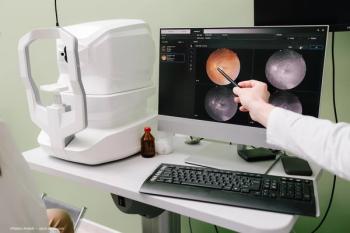
ARVO 2024: Analysis of anterior chamber inflammation through automated quantitative assessment of swept-source anterior segment OCT images
At this year's ARVO meeting, Edmund Tsui, MD, presented a paper on the analysis of anterior chamber inflammation through automated quantitative assessment of swept-source anterior segment OCT images.
At this year's ARVO meeting, Edmund Tsui, MD, presented a paper on the analysis of anterior chamber inflammation through automated quantitative assessment of swept-source anterior segment OCT images.
Video Transcript:
Editor's note: The below transcript has been lightly edited for clarity.
Edmund Tsui, MD:
Hello, my name is Edmund Tsui. I'm an assistant professor of ophthalmology and a uveitis specialist at the UCLA Stein Eye Institute in Los Angeles, California. I'm here at ARVO 2024, and I'm excited to present our work using swept-source anterior segment OCT from Heidelberg using the ANTERION platform to look at anterior chamber cells in patients with uveitis.
So this is the first of our 3 posters that we're presenting here. In our first study, we looked at 67 eyes with varying grades of inflammation based on the SUN, or standardization of uveitis nomenclature scale, and we quantified each of these patients using the swept source platform to look at the anterior chamber, we used an in house customized algorithm to identify the amount of cells in each patient. And we found that this correlated very well with the standardization of uveitis nomenclature or SUN clinical grading. Now, why is this important? This is important because we want to use a more objective measure to quantify patients inflammation.
Traditionally, we use the slit lamp examination, where the ophthalmologist grades or counts the amount of cells in the anterior chamber. But what OCT offers us, specifically swept-source anterior segment OCT, it offers us an opportunity to have a high-resolution, reproducible and objective and quantifiable method to quantify the anterior chamber inflammation. In sum, we hope to use this technology and algorithm to potentially better quantify patients with intraocular inflammation, and potentially roll this out into routine practice or as endpoints in clinical trials within the next few years. So for patients and ophthalmologists, this means that we can better monitor and evaluate anterior chamber information. Ultimately, this means that we can adjust the medications whether by increasing it or decreasing it based on a more accurate assessment of the anterior chamber.
I also want to acknowledge our collaborators for this research, Dr. Shani Pillar our uveitis fellow, Dr. Shin Kadomoto, who helped with the image processing and our collaborators Dr. Gary Holland and Vas Sadda as well as our research coordinators, who helped with image acquisition. And of course our patients who without this would not be possible.
Newsletter
Don’t miss out—get Ophthalmology Times updates on the latest clinical advancements and expert interviews, straight to your inbox.













































